OB Analysis: M&S Culture, Motivation, and Teamwork
VerifiedAdded on 2021/02/18
|19
|6787
|330
Report
AI Summary
This report provides a comprehensive analysis of the organizational behavior of Marks & Spencer (M&S). It begins by examining the company's culture, politics, and power dynamics, exploring how these factors influence individual and group behavior and performance. The report then delves into motivational theories, evaluating content and process explanations and motivational methods for achieving goals within an organizational structure. Furthermore, the report contrasts effective and ineffective teams, highlighting key characteristics and dynamics. Finally, it applies key concepts and philosophies of organizational behavior (OB) to the M&S context, providing a well-rounded understanding of how OB principles can be applied in a real-world business setting. The report uses Handy's model for organizational culture and Maslow's Hierarchy of Needs for motivation and discusses different types of power within an organization. The report emphasizes the importance of understanding and managing these aspects to improve employee performance and overall organizational success.
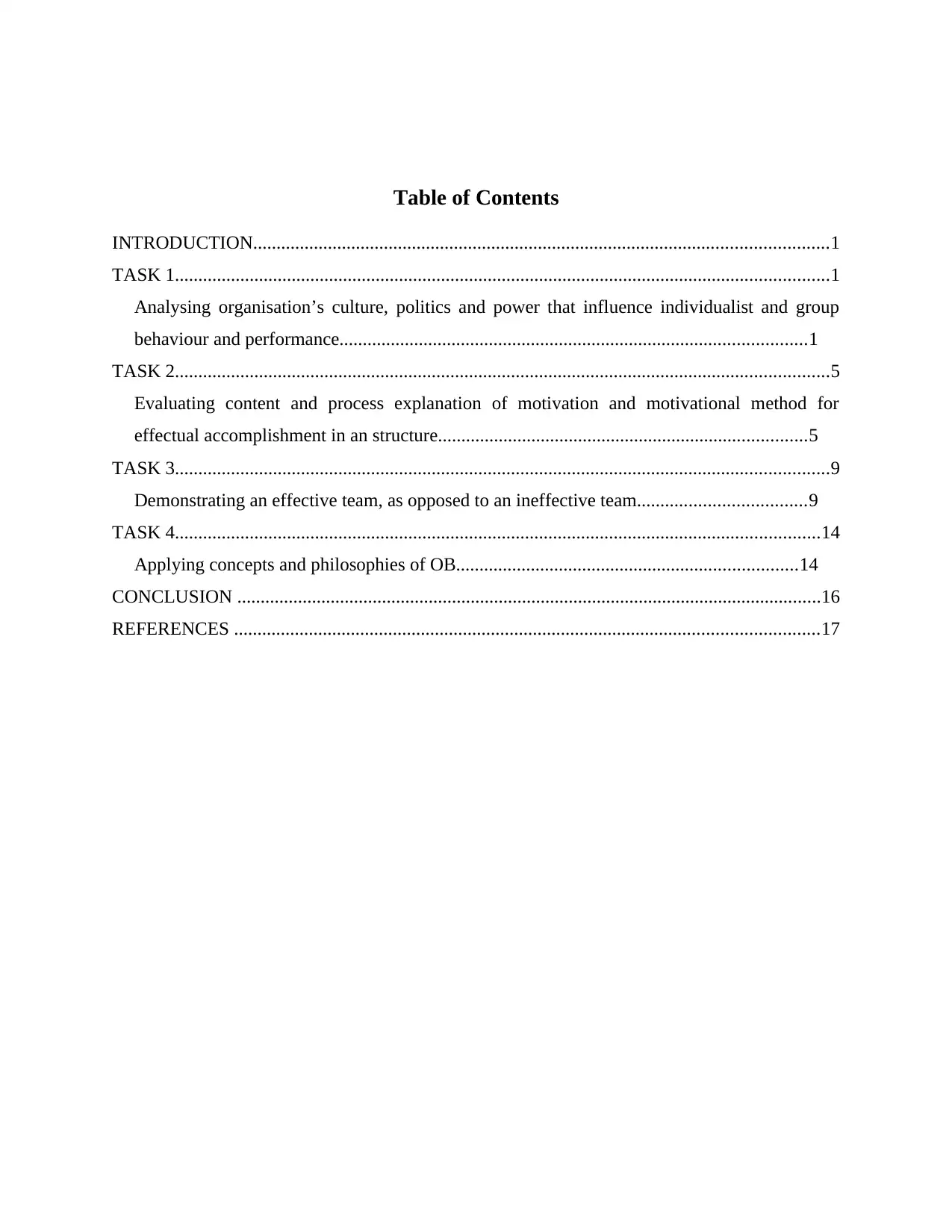
Table of Contents
INTRODUCTION...........................................................................................................................1
TASK 1............................................................................................................................................1
Analysing organisation’s culture, politics and power that influence individualist and group
behaviour and performance....................................................................................................1
TASK 2............................................................................................................................................5
Evaluating content and process explanation of motivation and motivational method for
effectual accomplishment in an structure...............................................................................5
TASK 3............................................................................................................................................9
Demonstrating an effective team, as opposed to an ineffective team....................................9
TASK 4..........................................................................................................................................14
Applying concepts and philosophies of OB.........................................................................14
CONCLUSION .............................................................................................................................16
REFERENCES .............................................................................................................................17
INTRODUCTION...........................................................................................................................1
TASK 1............................................................................................................................................1
Analysing organisation’s culture, politics and power that influence individualist and group
behaviour and performance....................................................................................................1
TASK 2............................................................................................................................................5
Evaluating content and process explanation of motivation and motivational method for
effectual accomplishment in an structure...............................................................................5
TASK 3............................................................................................................................................9
Demonstrating an effective team, as opposed to an ineffective team....................................9
TASK 4..........................................................................................................................................14
Applying concepts and philosophies of OB.........................................................................14
CONCLUSION .............................................................................................................................16
REFERENCES .............................................................................................................................17
Paraphrase This Document
Need a fresh take? Get an instant paraphrase of this document with our AI Paraphraser
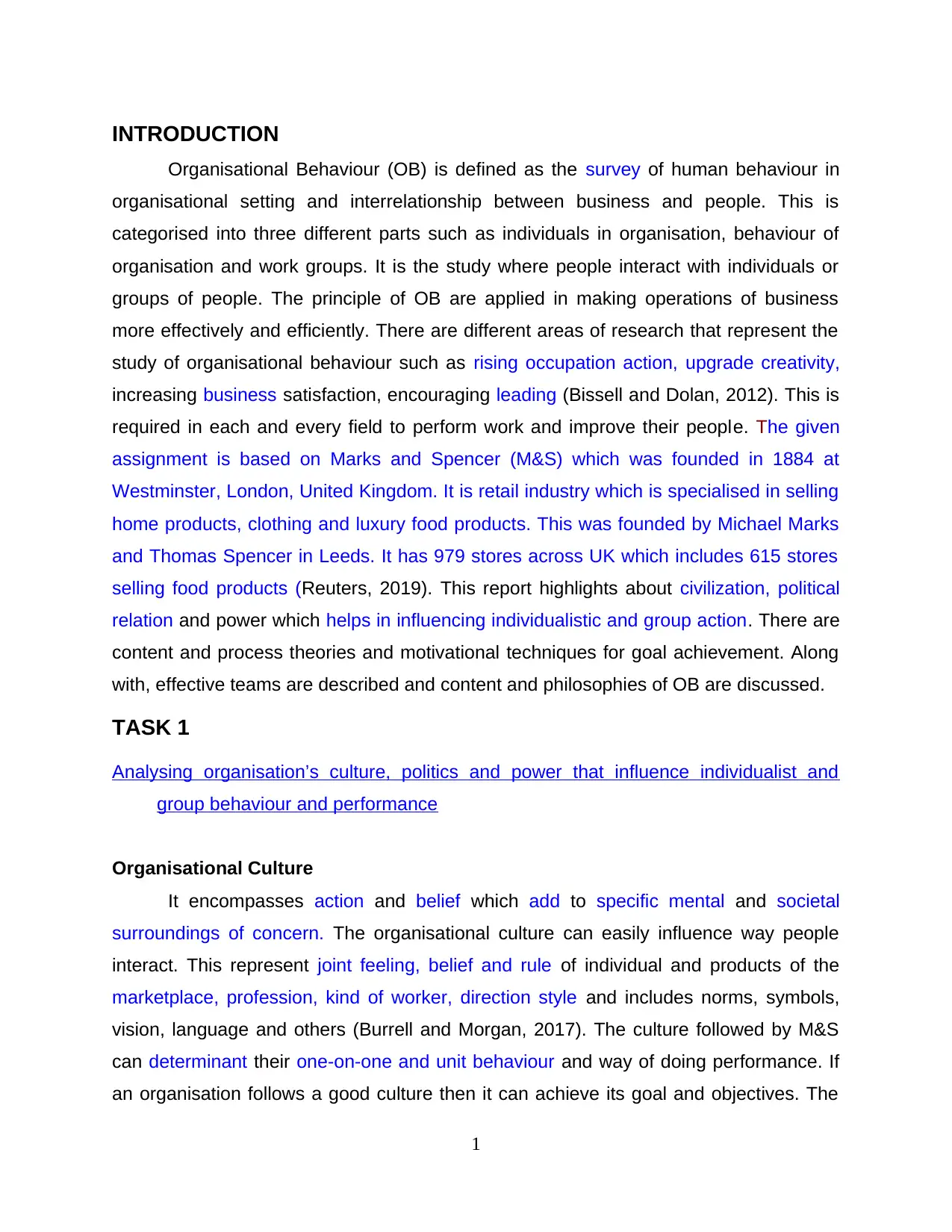
INTRODUCTION
Organisational Behaviour (OB) is defined as the survey of human behaviour in
organisational setting and interrelationship between business and people. This is
categorised into three different parts such as individuals in organisation, behaviour of
organisation and work groups. It is the study where people interact with individuals or
groups of people. The principle of OB are applied in making operations of business
more effectively and efficiently. There are different areas of research that represent the
study of organisational behaviour such as rising occupation action, upgrade creativity,
increasing business satisfaction, encouraging leading (Bissell and Dolan, 2012). This is
required in each and every field to perform work and improve their people. The given
assignment is based on Marks and Spencer (M&S) which was founded in 1884 at
Westminster, London, United Kingdom. It is retail industry which is specialised in selling
home products, clothing and luxury food products. This was founded by Michael Marks
and Thomas Spencer in Leeds. It has 979 stores across UK which includes 615 stores
selling food products (Reuters, 2019). This report highlights about civilization, political
relation and power which helps in influencing individualistic and group action. There are
content and process theories and motivational techniques for goal achievement. Along
with, effective teams are described and content and philosophies of OB are discussed.
TASK 1
Analysing organisation’s culture, politics and power that influence individualist and
group behaviour and performance
Organisational Culture
It encompasses action and belief which add to specific mental and societal
surroundings of concern. The organisational culture can easily influence way people
interact. This represent joint feeling, belief and rule of individual and products of the
marketplace, profession, kind of worker, direction style and includes norms, symbols,
vision, language and others (Burrell and Morgan, 2017). The culture followed by M&S
can determinant their one-on-one and unit behaviour and way of doing performance. If
an organisation follows a good culture then it can achieve its goal and objectives. The
1
Organisational Behaviour (OB) is defined as the survey of human behaviour in
organisational setting and interrelationship between business and people. This is
categorised into three different parts such as individuals in organisation, behaviour of
organisation and work groups. It is the study where people interact with individuals or
groups of people. The principle of OB are applied in making operations of business
more effectively and efficiently. There are different areas of research that represent the
study of organisational behaviour such as rising occupation action, upgrade creativity,
increasing business satisfaction, encouraging leading (Bissell and Dolan, 2012). This is
required in each and every field to perform work and improve their people. The given
assignment is based on Marks and Spencer (M&S) which was founded in 1884 at
Westminster, London, United Kingdom. It is retail industry which is specialised in selling
home products, clothing and luxury food products. This was founded by Michael Marks
and Thomas Spencer in Leeds. It has 979 stores across UK which includes 615 stores
selling food products (Reuters, 2019). This report highlights about civilization, political
relation and power which helps in influencing individualistic and group action. There are
content and process theories and motivational techniques for goal achievement. Along
with, effective teams are described and content and philosophies of OB are discussed.
TASK 1
Analysing organisation’s culture, politics and power that influence individualist and
group behaviour and performance
Organisational Culture
It encompasses action and belief which add to specific mental and societal
surroundings of concern. The organisational culture can easily influence way people
interact. This represent joint feeling, belief and rule of individual and products of the
marketplace, profession, kind of worker, direction style and includes norms, symbols,
vision, language and others (Burrell and Morgan, 2017). The culture followed by M&S
can determinant their one-on-one and unit behaviour and way of doing performance. If
an organisation follows a good culture then it can achieve its goal and objectives. The
1
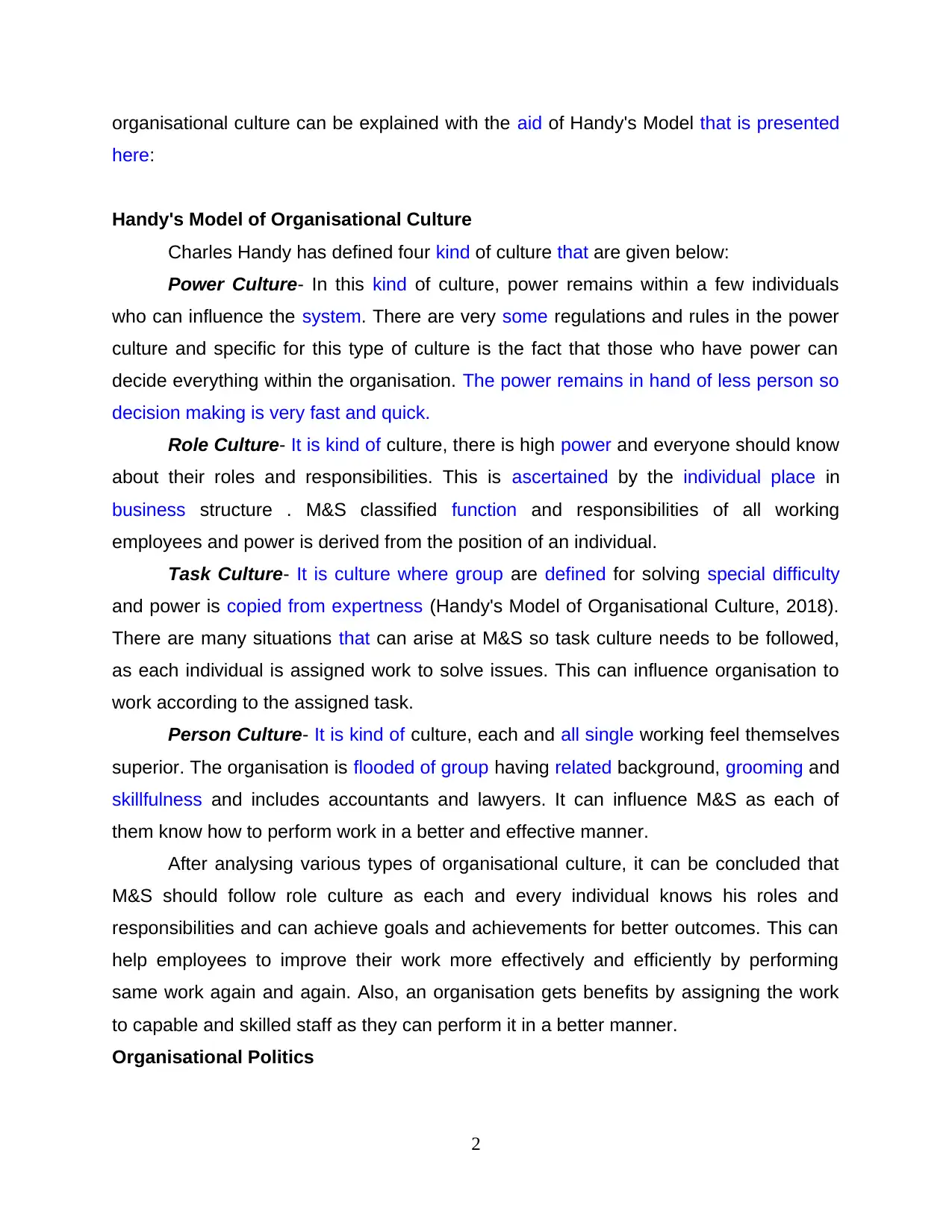
organisational culture can be explained with the aid of Handy's Model that is presented
here:
Handy's Model of Organisational Culture
Charles Handy has defined four kind of culture that are given below:
Power Culture- In this kind of culture, power remains within a few individuals
who can influence the system. There are very some regulations and rules in the power
culture and specific for this type of culture is the fact that those who have power can
decide everything within the organisation. The power remains in hand of less person so
decision making is very fast and quick.
Role Culture- It is kind of culture, there is high power and everyone should know
about their roles and responsibilities. This is ascertained by the individual place in
business structure . M&S classified function and responsibilities of all working
employees and power is derived from the position of an individual.
Task Culture- It is culture where group are defined for solving special difficulty
and power is copied from expertness (Handy's Model of Organisational Culture, 2018).
There are many situations that can arise at M&S so task culture needs to be followed,
as each individual is assigned work to solve issues. This can influence organisation to
work according to the assigned task.
Person Culture- It is kind of culture, each and all single working feel themselves
superior. The organisation is flooded of group having related background, grooming and
skillfulness and includes accountants and lawyers. It can influence M&S as each of
them know how to perform work in a better and effective manner.
After analysing various types of organisational culture, it can be concluded that
M&S should follow role culture as each and every individual knows his roles and
responsibilities and can achieve goals and achievements for better outcomes. This can
help employees to improve their work more effectively and efficiently by performing
same work again and again. Also, an organisation gets benefits by assigning the work
to capable and skilled staff as they can perform it in a better manner.
Organisational Politics
2
here:
Handy's Model of Organisational Culture
Charles Handy has defined four kind of culture that are given below:
Power Culture- In this kind of culture, power remains within a few individuals
who can influence the system. There are very some regulations and rules in the power
culture and specific for this type of culture is the fact that those who have power can
decide everything within the organisation. The power remains in hand of less person so
decision making is very fast and quick.
Role Culture- It is kind of culture, there is high power and everyone should know
about their roles and responsibilities. This is ascertained by the individual place in
business structure . M&S classified function and responsibilities of all working
employees and power is derived from the position of an individual.
Task Culture- It is culture where group are defined for solving special difficulty
and power is copied from expertness (Handy's Model of Organisational Culture, 2018).
There are many situations that can arise at M&S so task culture needs to be followed,
as each individual is assigned work to solve issues. This can influence organisation to
work according to the assigned task.
Person Culture- It is kind of culture, each and all single working feel themselves
superior. The organisation is flooded of group having related background, grooming and
skillfulness and includes accountants and lawyers. It can influence M&S as each of
them know how to perform work in a better and effective manner.
After analysing various types of organisational culture, it can be concluded that
M&S should follow role culture as each and every individual knows his roles and
responsibilities and can achieve goals and achievements for better outcomes. This can
help employees to improve their work more effectively and efficiently by performing
same work again and again. Also, an organisation gets benefits by assigning the work
to capable and skilled staff as they can perform it in a better manner.
Organisational Politics
2
⊘ This is a preview!⊘
Do you want full access?
Subscribe today to unlock all pages.

Trusted by 1+ million students worldwide
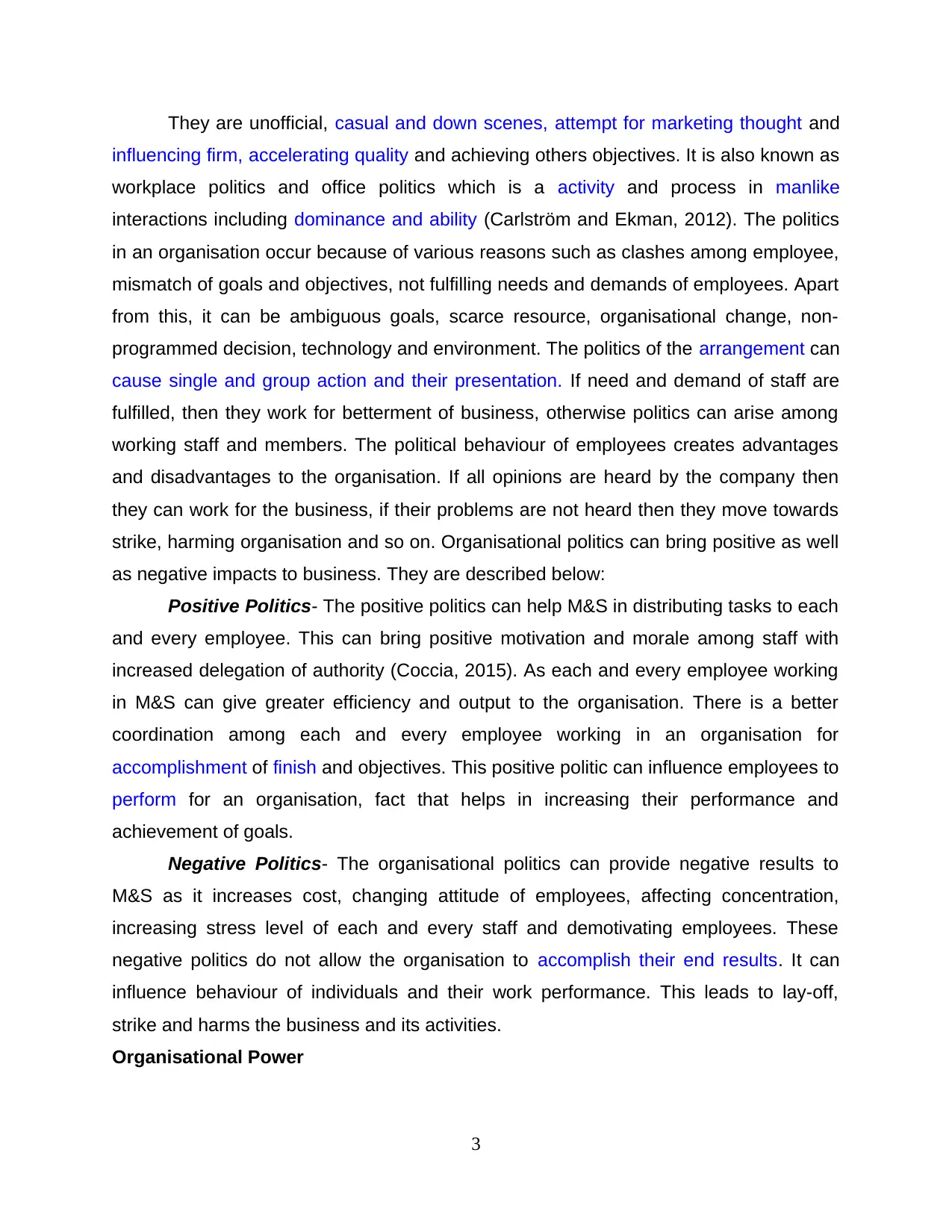
They are unofficial, casual and down scenes, attempt for marketing thought and
influencing firm, accelerating quality and achieving others objectives. It is also known as
workplace politics and office politics which is a activity and process in manlike
interactions including dominance and ability (Carlström and Ekman, 2012). The politics
in an organisation occur because of various reasons such as clashes among employee,
mismatch of goals and objectives, not fulfilling needs and demands of employees. Apart
from this, it can be ambiguous goals, scarce resource, organisational change, non-
programmed decision, technology and environment. The politics of the arrangement can
cause single and group action and their presentation. If need and demand of staff are
fulfilled, then they work for betterment of business, otherwise politics can arise among
working staff and members. The political behaviour of employees creates advantages
and disadvantages to the organisation. If all opinions are heard by the company then
they can work for the business, if their problems are not heard then they move towards
strike, harming organisation and so on. Organisational politics can bring positive as well
as negative impacts to business. They are described below:
Positive Politics- The positive politics can help M&S in distributing tasks to each
and every employee. This can bring positive motivation and morale among staff with
increased delegation of authority (Coccia, 2015). As each and every employee working
in M&S can give greater efficiency and output to the organisation. There is a better
coordination among each and every employee working in an organisation for
accomplishment of finish and objectives. This positive politic can influence employees to
perform for an organisation, fact that helps in increasing their performance and
achievement of goals.
Negative Politics- The organisational politics can provide negative results to
M&S as it increases cost, changing attitude of employees, affecting concentration,
increasing stress level of each and every staff and demotivating employees. These
negative politics do not allow the organisation to accomplish their end results. It can
influence behaviour of individuals and their work performance. This leads to lay-off,
strike and harms the business and its activities.
Organisational Power
3
influencing firm, accelerating quality and achieving others objectives. It is also known as
workplace politics and office politics which is a activity and process in manlike
interactions including dominance and ability (Carlström and Ekman, 2012). The politics
in an organisation occur because of various reasons such as clashes among employee,
mismatch of goals and objectives, not fulfilling needs and demands of employees. Apart
from this, it can be ambiguous goals, scarce resource, organisational change, non-
programmed decision, technology and environment. The politics of the arrangement can
cause single and group action and their presentation. If need and demand of staff are
fulfilled, then they work for betterment of business, otherwise politics can arise among
working staff and members. The political behaviour of employees creates advantages
and disadvantages to the organisation. If all opinions are heard by the company then
they can work for the business, if their problems are not heard then they move towards
strike, harming organisation and so on. Organisational politics can bring positive as well
as negative impacts to business. They are described below:
Positive Politics- The positive politics can help M&S in distributing tasks to each
and every employee. This can bring positive motivation and morale among staff with
increased delegation of authority (Coccia, 2015). As each and every employee working
in M&S can give greater efficiency and output to the organisation. There is a better
coordination among each and every employee working in an organisation for
accomplishment of finish and objectives. This positive politic can influence employees to
perform for an organisation, fact that helps in increasing their performance and
achievement of goals.
Negative Politics- The organisational politics can provide negative results to
M&S as it increases cost, changing attitude of employees, affecting concentration,
increasing stress level of each and every staff and demotivating employees. These
negative politics do not allow the organisation to accomplish their end results. It can
influence behaviour of individuals and their work performance. This leads to lay-off,
strike and harms the business and its activities.
Organisational Power
3
Paraphrase This Document
Need a fresh take? Get an instant paraphrase of this document with our AI Paraphraser
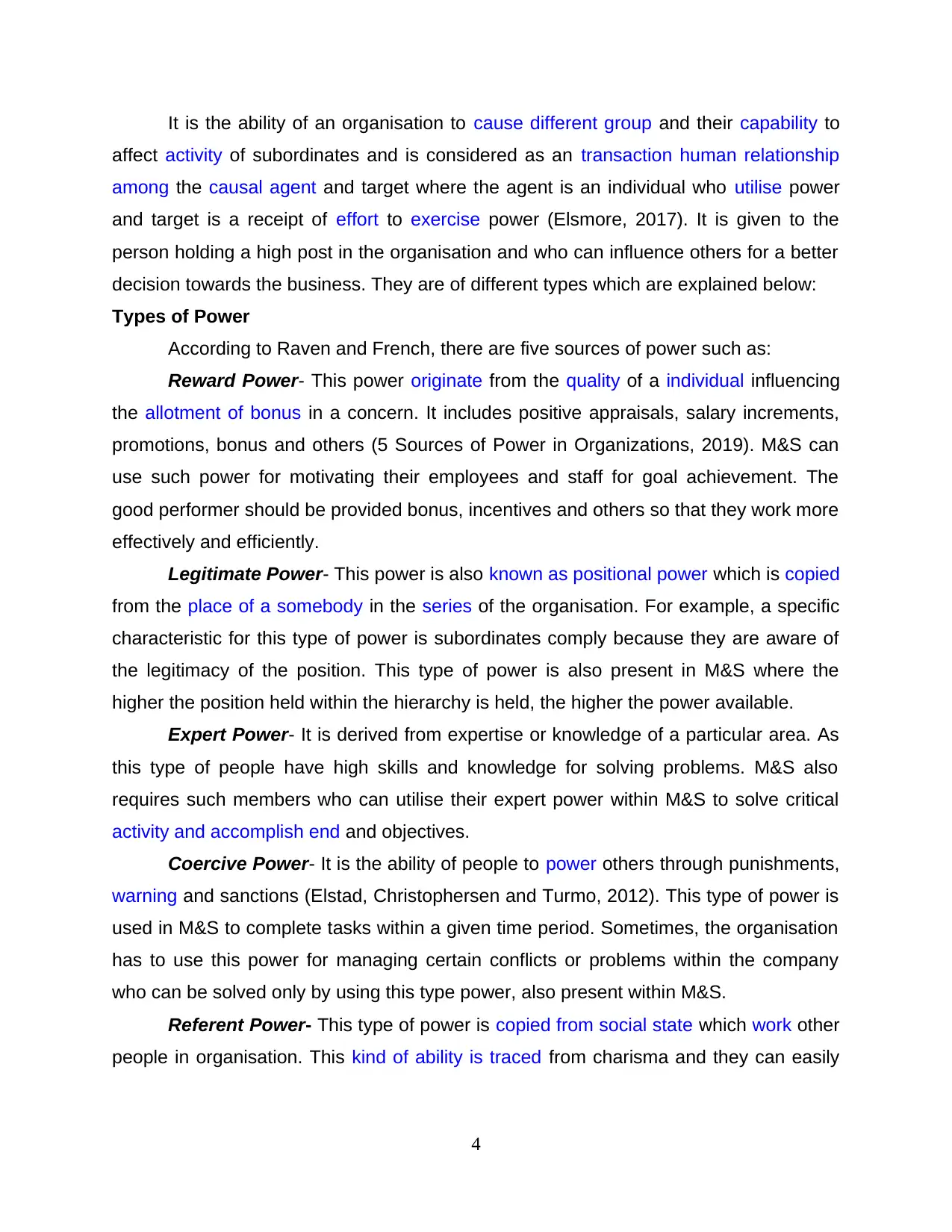
It is the ability of an organisation to cause different group and their capability to
affect activity of subordinates and is considered as an transaction human relationship
among the causal agent and target where the agent is an individual who utilise power
and target is a receipt of effort to exercise power (Elsmore, 2017). It is given to the
person holding a high post in the organisation and who can influence others for a better
decision towards the business. They are of different types which are explained below:
Types of Power
According to Raven and French, there are five sources of power such as:
Reward Power- This power originate from the quality of a individual influencing
the allotment of bonus in a concern. It includes positive appraisals, salary increments,
promotions, bonus and others (5 Sources of Power in Organizations, 2019). M&S can
use such power for motivating their employees and staff for goal achievement. The
good performer should be provided bonus, incentives and others so that they work more
effectively and efficiently.
Legitimate Power- This power is also known as positional power which is copied
from the place of a somebody in the series of the organisation. For example, a specific
characteristic for this type of power is subordinates comply because they are aware of
the legitimacy of the position. This type of power is also present in M&S where the
higher the position held within the hierarchy is held, the higher the power available.
Expert Power- It is derived from expertise or knowledge of a particular area. As
this type of people have high skills and knowledge for solving problems. M&S also
requires such members who can utilise their expert power within M&S to solve critical
activity and accomplish end and objectives.
Coercive Power- It is the ability of people to power others through punishments,
warning and sanctions (Elstad, Christophersen and Turmo, 2012). This type of power is
used in M&S to complete tasks within a given time period. Sometimes, the organisation
has to use this power for managing certain conflicts or problems within the company
who can be solved only by using this type power, also present within M&S.
Referent Power- This type of power is copied from social state which work other
people in organisation. This kind of ability is traced from charisma and they can easily
4
affect activity of subordinates and is considered as an transaction human relationship
among the causal agent and target where the agent is an individual who utilise power
and target is a receipt of effort to exercise power (Elsmore, 2017). It is given to the
person holding a high post in the organisation and who can influence others for a better
decision towards the business. They are of different types which are explained below:
Types of Power
According to Raven and French, there are five sources of power such as:
Reward Power- This power originate from the quality of a individual influencing
the allotment of bonus in a concern. It includes positive appraisals, salary increments,
promotions, bonus and others (5 Sources of Power in Organizations, 2019). M&S can
use such power for motivating their employees and staff for goal achievement. The
good performer should be provided bonus, incentives and others so that they work more
effectively and efficiently.
Legitimate Power- This power is also known as positional power which is copied
from the place of a somebody in the series of the organisation. For example, a specific
characteristic for this type of power is subordinates comply because they are aware of
the legitimacy of the position. This type of power is also present in M&S where the
higher the position held within the hierarchy is held, the higher the power available.
Expert Power- It is derived from expertise or knowledge of a particular area. As
this type of people have high skills and knowledge for solving problems. M&S also
requires such members who can utilise their expert power within M&S to solve critical
activity and accomplish end and objectives.
Coercive Power- It is the ability of people to power others through punishments,
warning and sanctions (Elstad, Christophersen and Turmo, 2012). This type of power is
used in M&S to complete tasks within a given time period. Sometimes, the organisation
has to use this power for managing certain conflicts or problems within the company
who can be solved only by using this type power, also present within M&S.
Referent Power- This type of power is copied from social state which work other
people in organisation. This kind of ability is traced from charisma and they can easily
4
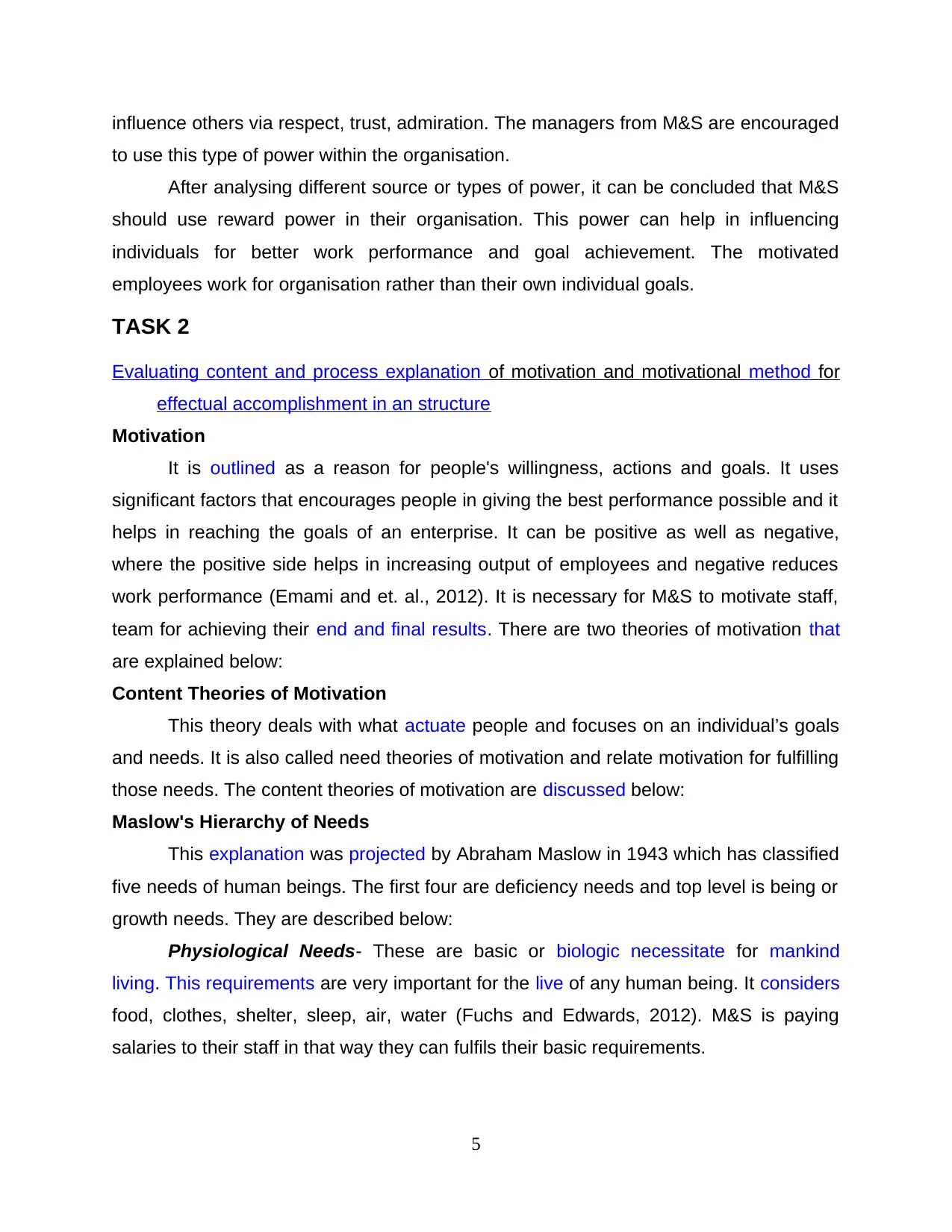
influence others via respect, trust, admiration. The managers from M&S are encouraged
to use this type of power within the organisation.
After analysing different source or types of power, it can be concluded that M&S
should use reward power in their organisation. This power can help in influencing
individuals for better work performance and goal achievement. The motivated
employees work for organisation rather than their own individual goals.
TASK 2
Evaluating content and process explanation of motivation and motivational method for
effectual accomplishment in an structure
Motivation
It is outlined as a reason for people's willingness, actions and goals. It uses
significant factors that encourages people in giving the best performance possible and it
helps in reaching the goals of an enterprise. It can be positive as well as negative,
where the positive side helps in increasing output of employees and negative reduces
work performance (Emami and et. al., 2012). It is necessary for M&S to motivate staff,
team for achieving their end and final results. There are two theories of motivation that
are explained below:
Content Theories of Motivation
This theory deals with what actuate people and focuses on an individual’s goals
and needs. It is also called need theories of motivation and relate motivation for fulfilling
those needs. The content theories of motivation are discussed below:
Maslow's Hierarchy of Needs
This explanation was projected by Abraham Maslow in 1943 which has classified
five needs of human beings. The first four are deficiency needs and top level is being or
growth needs. They are described below:
Physiological Needs- These are basic or biologic necessitate for mankind
living. This requirements are very important for the live of any human being. It considers
food, clothes, shelter, sleep, air, water (Fuchs and Edwards, 2012). M&S is paying
salaries to their staff in that way they can fulfils their basic requirements.
5
to use this type of power within the organisation.
After analysing different source or types of power, it can be concluded that M&S
should use reward power in their organisation. This power can help in influencing
individuals for better work performance and goal achievement. The motivated
employees work for organisation rather than their own individual goals.
TASK 2
Evaluating content and process explanation of motivation and motivational method for
effectual accomplishment in an structure
Motivation
It is outlined as a reason for people's willingness, actions and goals. It uses
significant factors that encourages people in giving the best performance possible and it
helps in reaching the goals of an enterprise. It can be positive as well as negative,
where the positive side helps in increasing output of employees and negative reduces
work performance (Emami and et. al., 2012). It is necessary for M&S to motivate staff,
team for achieving their end and final results. There are two theories of motivation that
are explained below:
Content Theories of Motivation
This theory deals with what actuate people and focuses on an individual’s goals
and needs. It is also called need theories of motivation and relate motivation for fulfilling
those needs. The content theories of motivation are discussed below:
Maslow's Hierarchy of Needs
This explanation was projected by Abraham Maslow in 1943 which has classified
five needs of human beings. The first four are deficiency needs and top level is being or
growth needs. They are described below:
Physiological Needs- These are basic or biologic necessitate for mankind
living. This requirements are very important for the live of any human being. It considers
food, clothes, shelter, sleep, air, water (Fuchs and Edwards, 2012). M&S is paying
salaries to their staff in that way they can fulfils their basic requirements.
5
⊘ This is a preview!⊘
Do you want full access?
Subscribe today to unlock all pages.

Trusted by 1+ million students worldwide
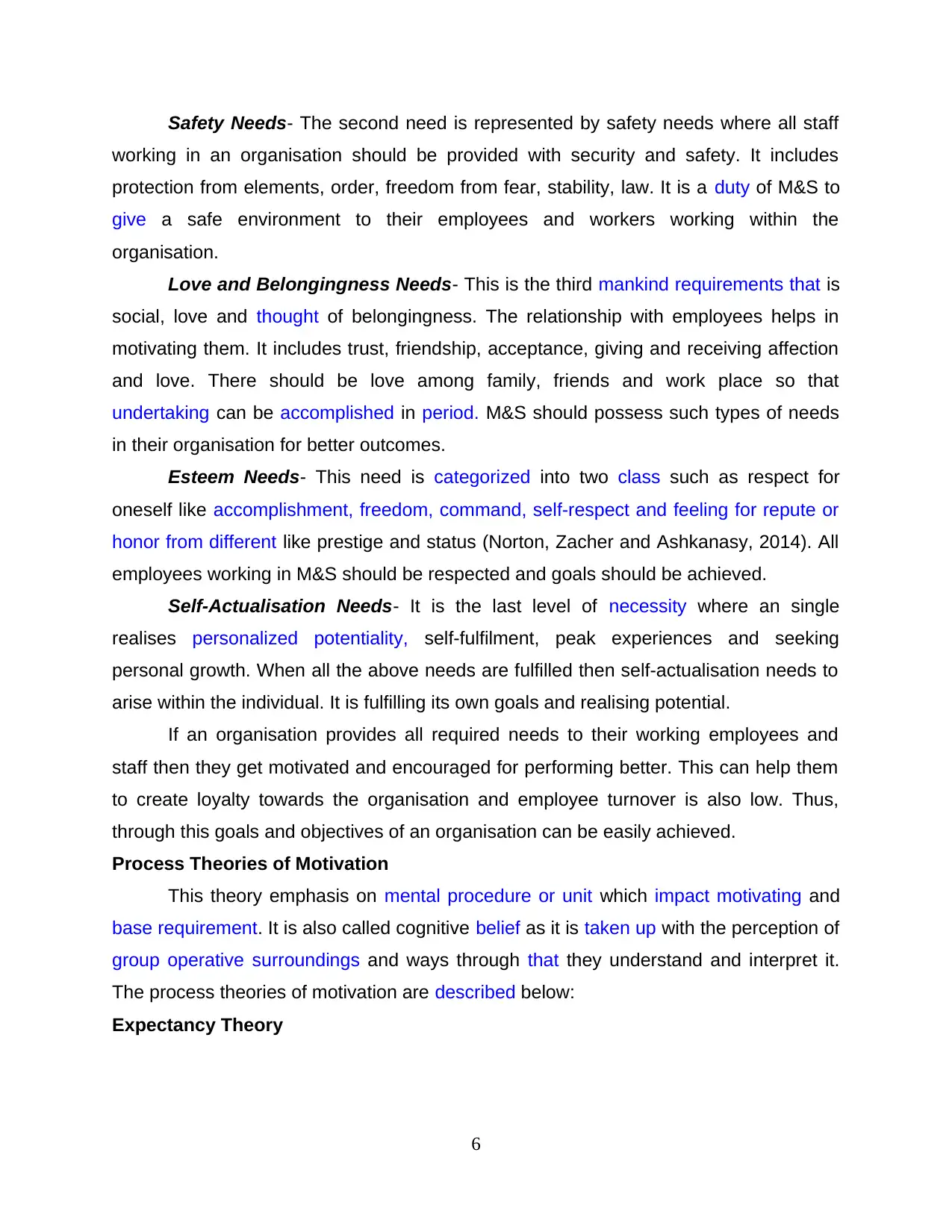
Safety Needs- The second need is represented by safety needs where all staff
working in an organisation should be provided with security and safety. It includes
protection from elements, order, freedom from fear, stability, law. It is a duty of M&S to
give a safe environment to their employees and workers working within the
organisation.
Love and Belongingness Needs- This is the third mankind requirements that is
social, love and thought of belongingness. The relationship with employees helps in
motivating them. It includes trust, friendship, acceptance, giving and receiving affection
and love. There should be love among family, friends and work place so that
undertaking can be accomplished in period. M&S should possess such types of needs
in their organisation for better outcomes.
Esteem Needs- This need is categorized into two class such as respect for
oneself like accomplishment, freedom, command, self-respect and feeling for repute or
honor from different like prestige and status (Norton, Zacher and Ashkanasy, 2014). All
employees working in M&S should be respected and goals should be achieved.
Self-Actualisation Needs- It is the last level of necessity where an single
realises personalized potentiality, self-fulfilment, peak experiences and seeking
personal growth. When all the above needs are fulfilled then self-actualisation needs to
arise within the individual. It is fulfilling its own goals and realising potential.
If an organisation provides all required needs to their working employees and
staff then they get motivated and encouraged for performing better. This can help them
to create loyalty towards the organisation and employee turnover is also low. Thus,
through this goals and objectives of an organisation can be easily achieved.
Process Theories of Motivation
This theory emphasis on mental procedure or unit which impact motivating and
base requirement. It is also called cognitive belief as it is taken up with the perception of
group operative surroundings and ways through that they understand and interpret it.
The process theories of motivation are described below:
Expectancy Theory
6
working in an organisation should be provided with security and safety. It includes
protection from elements, order, freedom from fear, stability, law. It is a duty of M&S to
give a safe environment to their employees and workers working within the
organisation.
Love and Belongingness Needs- This is the third mankind requirements that is
social, love and thought of belongingness. The relationship with employees helps in
motivating them. It includes trust, friendship, acceptance, giving and receiving affection
and love. There should be love among family, friends and work place so that
undertaking can be accomplished in period. M&S should possess such types of needs
in their organisation for better outcomes.
Esteem Needs- This need is categorized into two class such as respect for
oneself like accomplishment, freedom, command, self-respect and feeling for repute or
honor from different like prestige and status (Norton, Zacher and Ashkanasy, 2014). All
employees working in M&S should be respected and goals should be achieved.
Self-Actualisation Needs- It is the last level of necessity where an single
realises personalized potentiality, self-fulfilment, peak experiences and seeking
personal growth. When all the above needs are fulfilled then self-actualisation needs to
arise within the individual. It is fulfilling its own goals and realising potential.
If an organisation provides all required needs to their working employees and
staff then they get motivated and encouraged for performing better. This can help them
to create loyalty towards the organisation and employee turnover is also low. Thus,
through this goals and objectives of an organisation can be easily achieved.
Process Theories of Motivation
This theory emphasis on mental procedure or unit which impact motivating and
base requirement. It is also called cognitive belief as it is taken up with the perception of
group operative surroundings and ways through that they understand and interpret it.
The process theories of motivation are described below:
Expectancy Theory
6
Paraphrase This Document
Need a fresh take? Get an instant paraphrase of this document with our AI Paraphraser
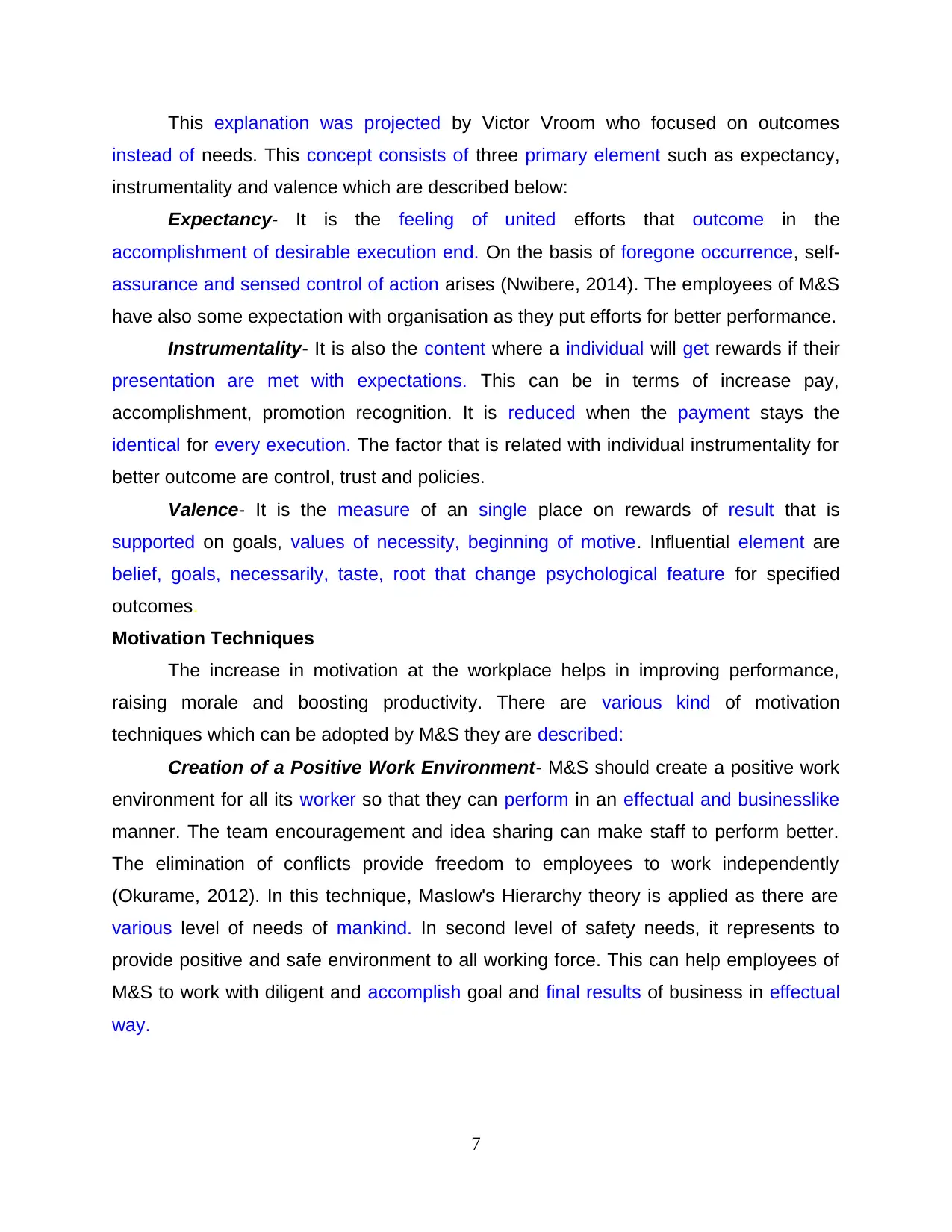
This explanation was projected by Victor Vroom who focused on outcomes
instead of needs. This concept consists of three primary element such as expectancy,
instrumentality and valence which are described below:
Expectancy- It is the feeling of united efforts that outcome in the
accomplishment of desirable execution end. On the basis of foregone occurrence, self-
assurance and sensed control of action arises (Nwibere, 2014). The employees of M&S
have also some expectation with organisation as they put efforts for better performance.
Instrumentality- It is also the content where a individual will get rewards if their
presentation are met with expectations. This can be in terms of increase pay,
accomplishment, promotion recognition. It is reduced when the payment stays the
identical for every execution. The factor that is related with individual instrumentality for
better outcome are control, trust and policies.
Valence- It is the measure of an single place on rewards of result that is
supported on goals, values of necessity, beginning of motive. Influential element are
belief, goals, necessarily, taste, root that change psychological feature for specified
outcomes.
Motivation Techniques
The increase in motivation at the workplace helps in improving performance,
raising morale and boosting productivity. There are various kind of motivation
techniques which can be adopted by M&S they are described:
Creation of a Positive Work Environment- M&S should create a positive work
environment for all its worker so that they can perform in an effectual and businesslike
manner. The team encouragement and idea sharing can make staff to perform better.
The elimination of conflicts provide freedom to employees to work independently
(Okurame, 2012). In this technique, Maslow's Hierarchy theory is applied as there are
various level of needs of mankind. In second level of safety needs, it represents to
provide positive and safe environment to all working force. This can help employees of
M&S to work with diligent and accomplish goal and final results of business in effectual
way.
7
instead of needs. This concept consists of three primary element such as expectancy,
instrumentality and valence which are described below:
Expectancy- It is the feeling of united efforts that outcome in the
accomplishment of desirable execution end. On the basis of foregone occurrence, self-
assurance and sensed control of action arises (Nwibere, 2014). The employees of M&S
have also some expectation with organisation as they put efforts for better performance.
Instrumentality- It is also the content where a individual will get rewards if their
presentation are met with expectations. This can be in terms of increase pay,
accomplishment, promotion recognition. It is reduced when the payment stays the
identical for every execution. The factor that is related with individual instrumentality for
better outcome are control, trust and policies.
Valence- It is the measure of an single place on rewards of result that is
supported on goals, values of necessity, beginning of motive. Influential element are
belief, goals, necessarily, taste, root that change psychological feature for specified
outcomes.
Motivation Techniques
The increase in motivation at the workplace helps in improving performance,
raising morale and boosting productivity. There are various kind of motivation
techniques which can be adopted by M&S they are described:
Creation of a Positive Work Environment- M&S should create a positive work
environment for all its worker so that they can perform in an effectual and businesslike
manner. The team encouragement and idea sharing can make staff to perform better.
The elimination of conflicts provide freedom to employees to work independently
(Okurame, 2012). In this technique, Maslow's Hierarchy theory is applied as there are
various level of needs of mankind. In second level of safety needs, it represents to
provide positive and safe environment to all working force. This can help employees of
M&S to work with diligent and accomplish goal and final results of business in effectual
way.
7
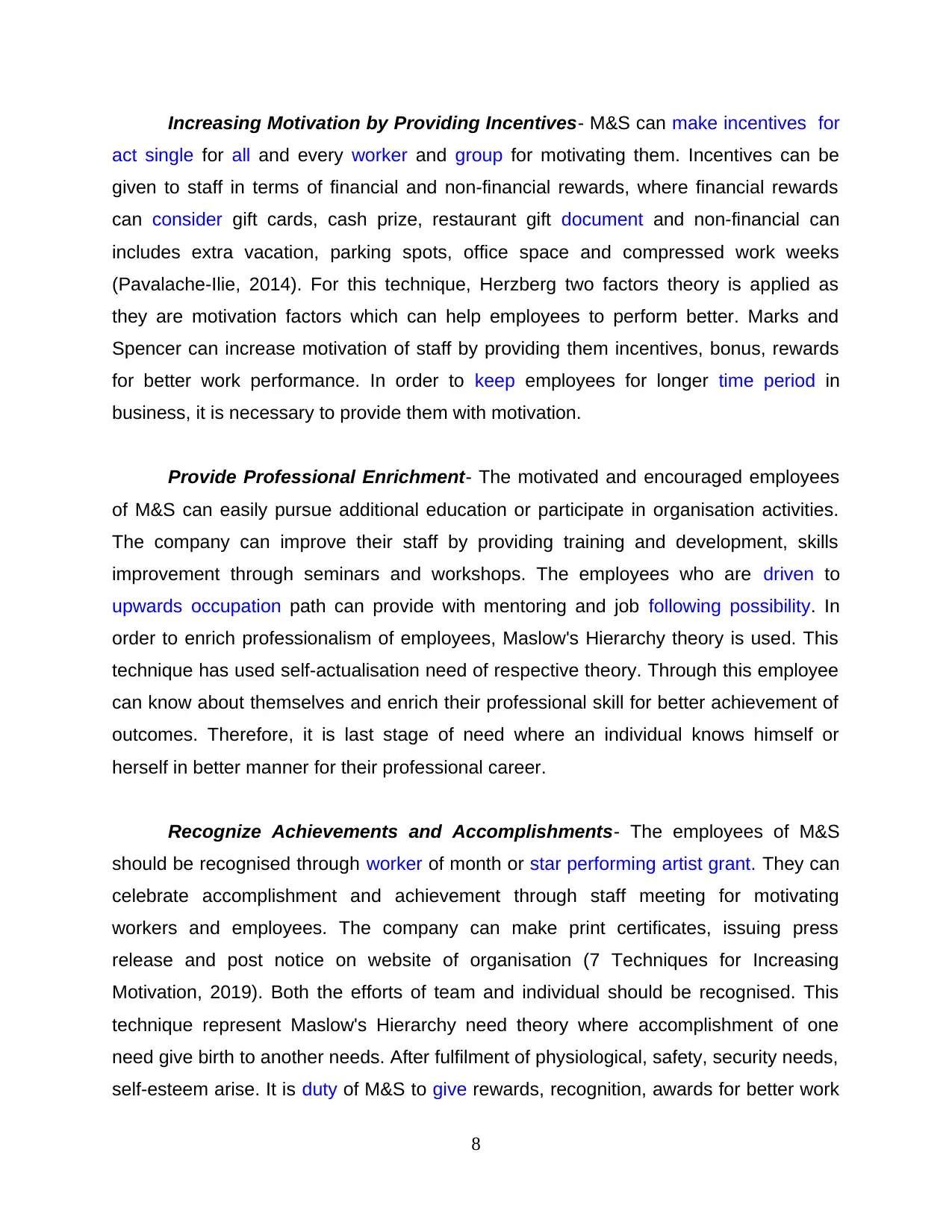
Increasing Motivation by Providing Incentives- M&S can make incentives for
act single for all and every worker and group for motivating them. Incentives can be
given to staff in terms of financial and non-financial rewards, where financial rewards
can consider gift cards, cash prize, restaurant gift document and non-financial can
includes extra vacation, parking spots, office space and compressed work weeks
(Pavalache-Ilie, 2014). For this technique, Herzberg two factors theory is applied as
they are motivation factors which can help employees to perform better. Marks and
Spencer can increase motivation of staff by providing them incentives, bonus, rewards
for better work performance. In order to keep employees for longer time period in
business, it is necessary to provide them with motivation.
Provide Professional Enrichment- The motivated and encouraged employees
of M&S can easily pursue additional education or participate in organisation activities.
The company can improve their staff by providing training and development, skills
improvement through seminars and workshops. The employees who are driven to
upwards occupation path can provide with mentoring and job following possibility. In
order to enrich professionalism of employees, Maslow's Hierarchy theory is used. This
technique has used self-actualisation need of respective theory. Through this employee
can know about themselves and enrich their professional skill for better achievement of
outcomes. Therefore, it is last stage of need where an individual knows himself or
herself in better manner for their professional career.
Recognize Achievements and Accomplishments- The employees of M&S
should be recognised through worker of month or star performing artist grant. They can
celebrate accomplishment and achievement through staff meeting for motivating
workers and employees. The company can make print certificates, issuing press
release and post notice on website of organisation (7 Techniques for Increasing
Motivation, 2019). Both the efforts of team and individual should be recognised. This
technique represent Maslow's Hierarchy need theory where accomplishment of one
need give birth to another needs. After fulfilment of physiological, safety, security needs,
self-esteem arise. It is duty of M&S to give rewards, recognition, awards for better work
8
act single for all and every worker and group for motivating them. Incentives can be
given to staff in terms of financial and non-financial rewards, where financial rewards
can consider gift cards, cash prize, restaurant gift document and non-financial can
includes extra vacation, parking spots, office space and compressed work weeks
(Pavalache-Ilie, 2014). For this technique, Herzberg two factors theory is applied as
they are motivation factors which can help employees to perform better. Marks and
Spencer can increase motivation of staff by providing them incentives, bonus, rewards
for better work performance. In order to keep employees for longer time period in
business, it is necessary to provide them with motivation.
Provide Professional Enrichment- The motivated and encouraged employees
of M&S can easily pursue additional education or participate in organisation activities.
The company can improve their staff by providing training and development, skills
improvement through seminars and workshops. The employees who are driven to
upwards occupation path can provide with mentoring and job following possibility. In
order to enrich professionalism of employees, Maslow's Hierarchy theory is used. This
technique has used self-actualisation need of respective theory. Through this employee
can know about themselves and enrich their professional skill for better achievement of
outcomes. Therefore, it is last stage of need where an individual knows himself or
herself in better manner for their professional career.
Recognize Achievements and Accomplishments- The employees of M&S
should be recognised through worker of month or star performing artist grant. They can
celebrate accomplishment and achievement through staff meeting for motivating
workers and employees. The company can make print certificates, issuing press
release and post notice on website of organisation (7 Techniques for Increasing
Motivation, 2019). Both the efforts of team and individual should be recognised. This
technique represent Maslow's Hierarchy need theory where accomplishment of one
need give birth to another needs. After fulfilment of physiological, safety, security needs,
self-esteem arise. It is duty of M&S to give rewards, recognition, awards for better work
8
⊘ This is a preview!⊘
Do you want full access?
Subscribe today to unlock all pages.

Trusted by 1+ million students worldwide
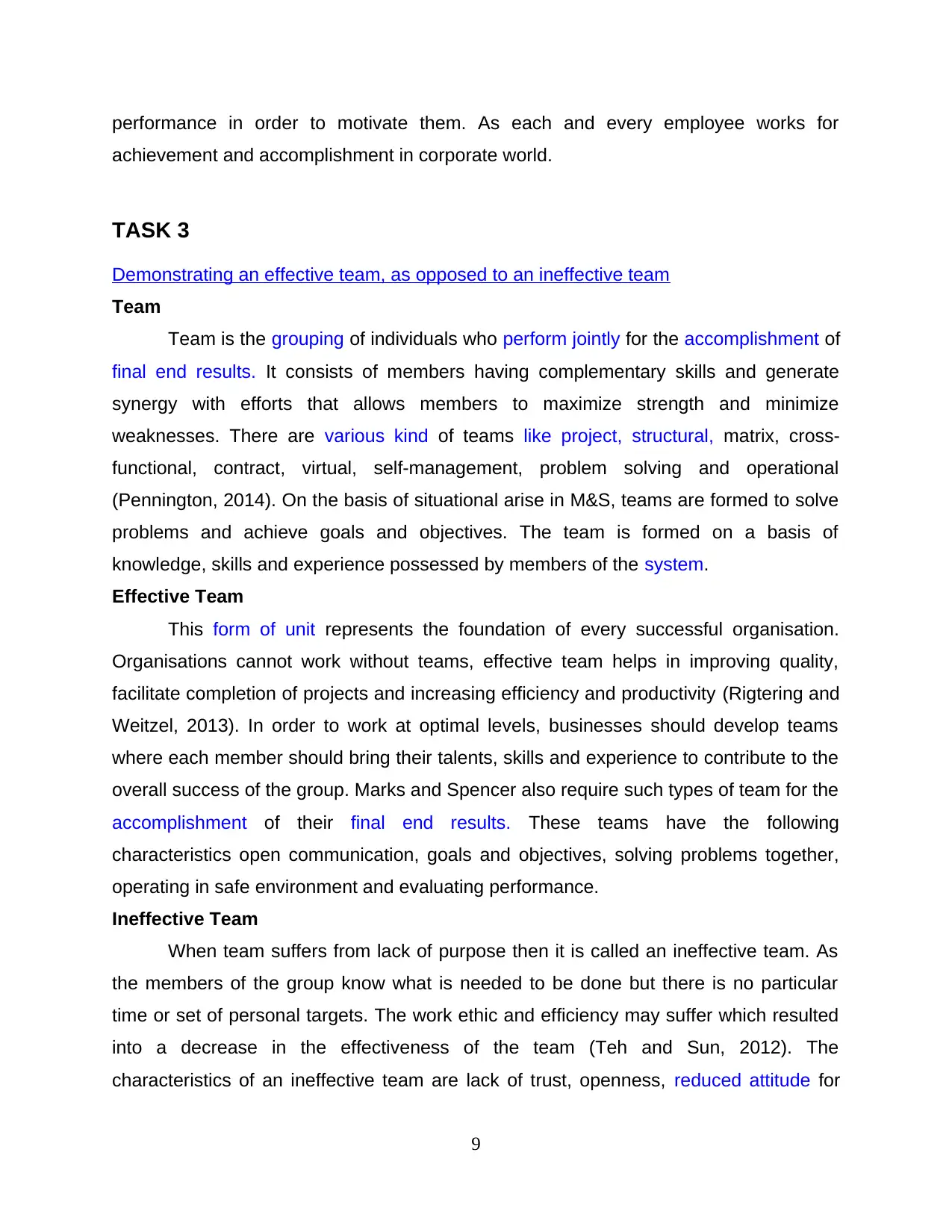
performance in order to motivate them. As each and every employee works for
achievement and accomplishment in corporate world.
TASK 3
Demonstrating an effective team, as opposed to an ineffective team
Team
Team is the grouping of individuals who perform jointly for the accomplishment of
final end results. It consists of members having complementary skills and generate
synergy with efforts that allows members to maximize strength and minimize
weaknesses. There are various kind of teams like project, structural, matrix, cross-
functional, contract, virtual, self-management, problem solving and operational
(Pennington, 2014). On the basis of situational arise in M&S, teams are formed to solve
problems and achieve goals and objectives. The team is formed on a basis of
knowledge, skills and experience possessed by members of the system.
Effective Team
This form of unit represents the foundation of every successful organisation.
Organisations cannot work without teams, effective team helps in improving quality,
facilitate completion of projects and increasing efficiency and productivity (Rigtering and
Weitzel, 2013). In order to work at optimal levels, businesses should develop teams
where each member should bring their talents, skills and experience to contribute to the
overall success of the group. Marks and Spencer also require such types of team for the
accomplishment of their final end results. These teams have the following
characteristics open communication, goals and objectives, solving problems together,
operating in safe environment and evaluating performance.
Ineffective Team
When team suffers from lack of purpose then it is called an ineffective team. As
the members of the group know what is needed to be done but there is no particular
time or set of personal targets. The work ethic and efficiency may suffer which resulted
into a decrease in the effectiveness of the team (Teh and Sun, 2012). The
characteristics of an ineffective team are lack of trust, openness, reduced attitude for
9
achievement and accomplishment in corporate world.
TASK 3
Demonstrating an effective team, as opposed to an ineffective team
Team
Team is the grouping of individuals who perform jointly for the accomplishment of
final end results. It consists of members having complementary skills and generate
synergy with efforts that allows members to maximize strength and minimize
weaknesses. There are various kind of teams like project, structural, matrix, cross-
functional, contract, virtual, self-management, problem solving and operational
(Pennington, 2014). On the basis of situational arise in M&S, teams are formed to solve
problems and achieve goals and objectives. The team is formed on a basis of
knowledge, skills and experience possessed by members of the system.
Effective Team
This form of unit represents the foundation of every successful organisation.
Organisations cannot work without teams, effective team helps in improving quality,
facilitate completion of projects and increasing efficiency and productivity (Rigtering and
Weitzel, 2013). In order to work at optimal levels, businesses should develop teams
where each member should bring their talents, skills and experience to contribute to the
overall success of the group. Marks and Spencer also require such types of team for the
accomplishment of their final end results. These teams have the following
characteristics open communication, goals and objectives, solving problems together,
operating in safe environment and evaluating performance.
Ineffective Team
When team suffers from lack of purpose then it is called an ineffective team. As
the members of the group know what is needed to be done but there is no particular
time or set of personal targets. The work ethic and efficiency may suffer which resulted
into a decrease in the effectiveness of the team (Teh and Sun, 2012). The
characteristics of an ineffective team are lack of trust, openness, reduced attitude for
9
Paraphrase This Document
Need a fresh take? Get an instant paraphrase of this document with our AI Paraphraser
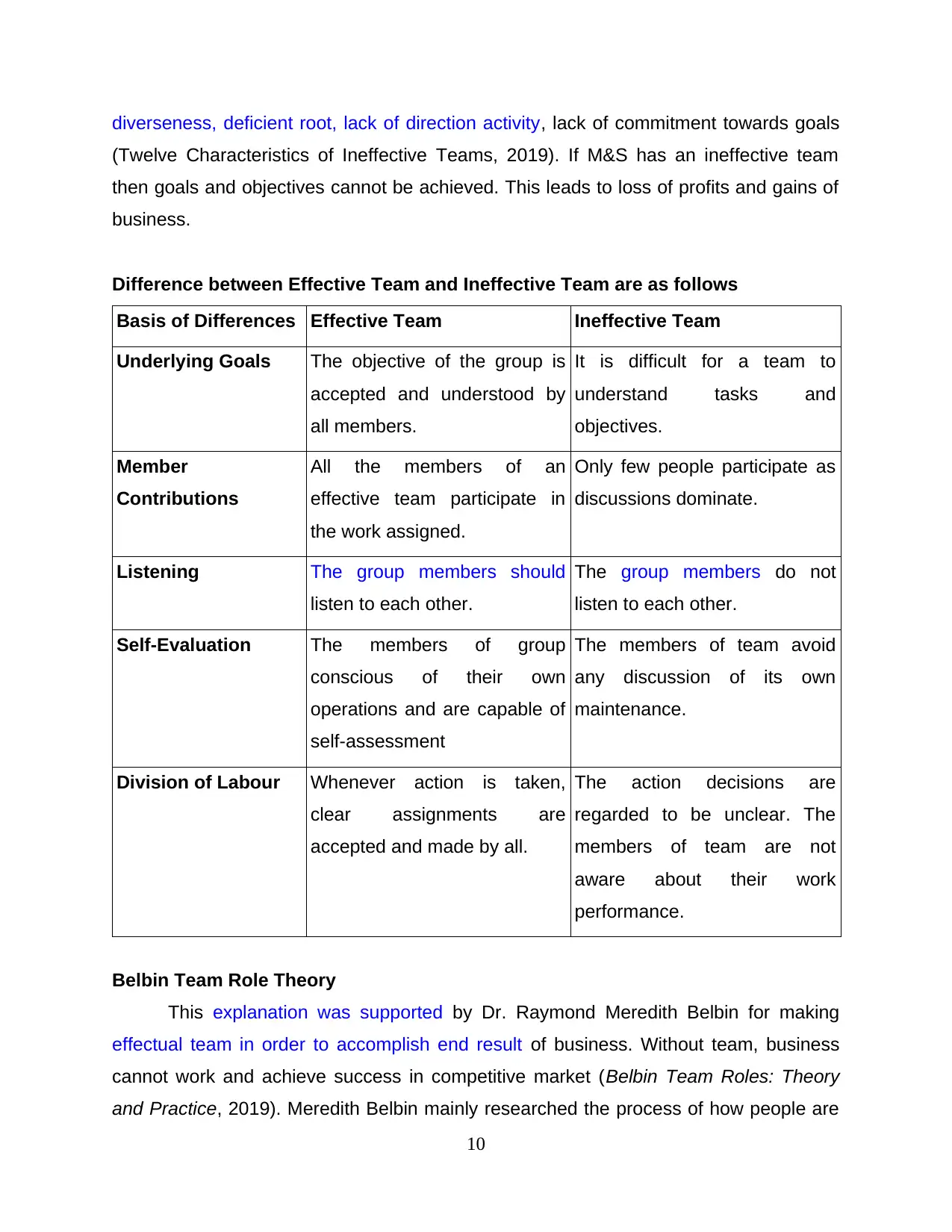
diverseness, deficient root, lack of direction activity, lack of commitment towards goals
(Twelve Characteristics of Ineffective Teams, 2019). If M&S has an ineffective team
then goals and objectives cannot be achieved. This leads to loss of profits and gains of
business.
Difference between Effective Team and Ineffective Team are as follows
Basis of Differences Effective Team Ineffective Team
Underlying Goals The objective of the group is
accepted and understood by
all members.
It is difficult for a team to
understand tasks and
objectives.
Member
Contributions
All the members of an
effective team participate in
the work assigned.
Only few people participate as
discussions dominate.
Listening The group members should
listen to each other.
The group members do not
listen to each other.
Self-Evaluation The members of group
conscious of their own
operations and are capable of
self-assessment
The members of team avoid
any discussion of its own
maintenance.
Division of Labour Whenever action is taken,
clear assignments are
accepted and made by all.
The action decisions are
regarded to be unclear. The
members of team are not
aware about their work
performance.
Belbin Team Role Theory
This explanation was supported by Dr. Raymond Meredith Belbin for making
effectual team in order to accomplish end result of business. Without team, business
cannot work and achieve success in competitive market (Belbin Team Roles: Theory
and Practice, 2019). Meredith Belbin mainly researched the process of how people are
10
(Twelve Characteristics of Ineffective Teams, 2019). If M&S has an ineffective team
then goals and objectives cannot be achieved. This leads to loss of profits and gains of
business.
Difference between Effective Team and Ineffective Team are as follows
Basis of Differences Effective Team Ineffective Team
Underlying Goals The objective of the group is
accepted and understood by
all members.
It is difficult for a team to
understand tasks and
objectives.
Member
Contributions
All the members of an
effective team participate in
the work assigned.
Only few people participate as
discussions dominate.
Listening The group members should
listen to each other.
The group members do not
listen to each other.
Self-Evaluation The members of group
conscious of their own
operations and are capable of
self-assessment
The members of team avoid
any discussion of its own
maintenance.
Division of Labour Whenever action is taken,
clear assignments are
accepted and made by all.
The action decisions are
regarded to be unclear. The
members of team are not
aware about their work
performance.
Belbin Team Role Theory
This explanation was supported by Dr. Raymond Meredith Belbin for making
effectual team in order to accomplish end result of business. Without team, business
cannot work and achieve success in competitive market (Belbin Team Roles: Theory
and Practice, 2019). Meredith Belbin mainly researched the process of how people are
10
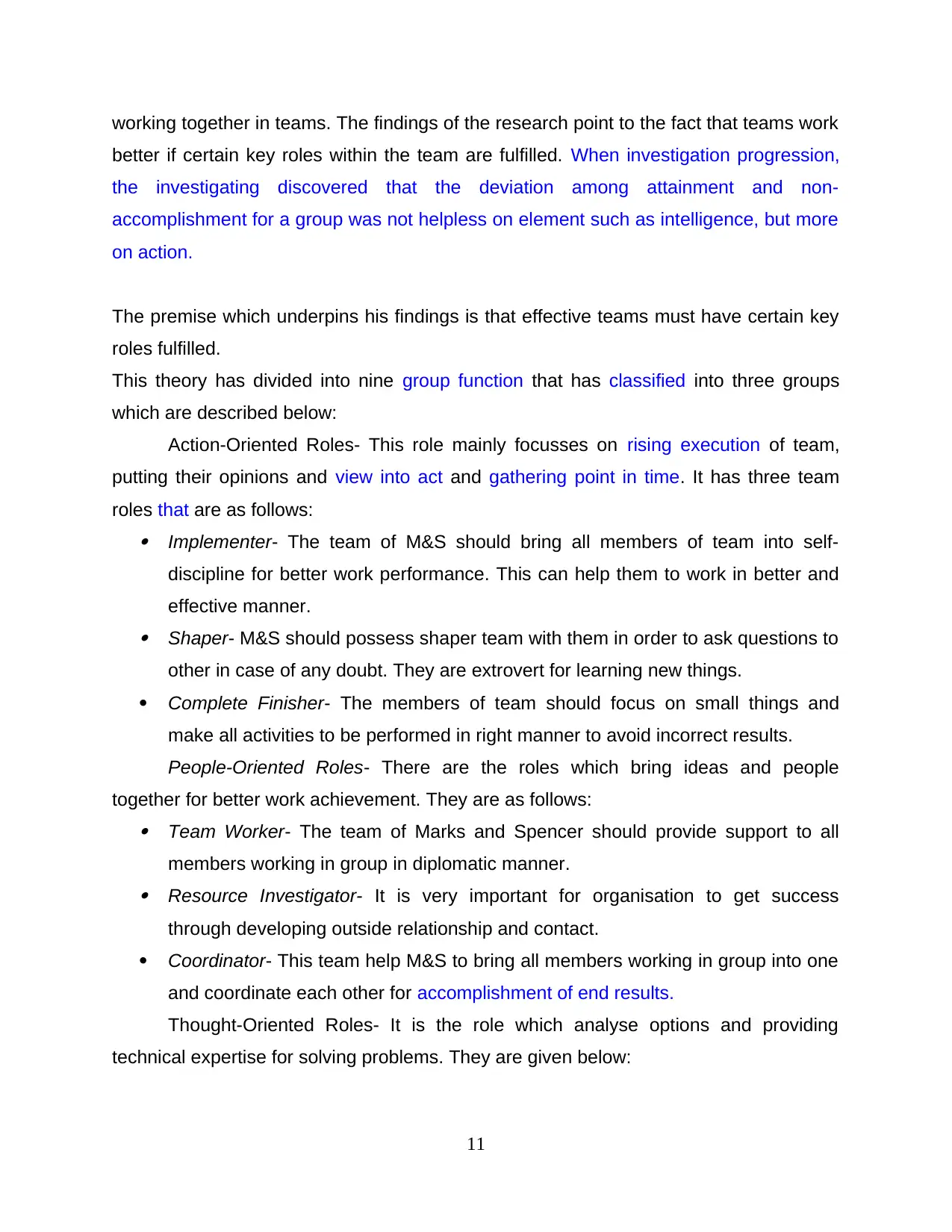
working together in teams. The findings of the research point to the fact that teams work
better if certain key roles within the team are fulfilled. When investigation progression,
the investigating discovered that the deviation among attainment and non-
accomplishment for a group was not helpless on element such as intelligence, but more
on action.
The premise which underpins his findings is that effective teams must have certain key
roles fulfilled.
This theory has divided into nine group function that has classified into three groups
which are described below:
Action-Oriented Roles- This role mainly focusses on rising execution of team,
putting their opinions and view into act and gathering point in time. It has three team
roles that are as follows: Implementer- The team of M&S should bring all members of team into self-
discipline for better work performance. This can help them to work in better and
effective manner. Shaper- M&S should possess shaper team with them in order to ask questions to
other in case of any doubt. They are extrovert for learning new things.
Complete Finisher- The members of team should focus on small things and
make all activities to be performed in right manner to avoid incorrect results.
People-Oriented Roles- There are the roles which bring ideas and people
together for better work achievement. They are as follows: Team Worker- The team of Marks and Spencer should provide support to all
members working in group in diplomatic manner. Resource Investigator- It is very important for organisation to get success
through developing outside relationship and contact.
Coordinator- This team help M&S to bring all members working in group into one
and coordinate each other for accomplishment of end results.
Thought-Oriented Roles- It is the role which analyse options and providing
technical expertise for solving problems. They are given below:
11
better if certain key roles within the team are fulfilled. When investigation progression,
the investigating discovered that the deviation among attainment and non-
accomplishment for a group was not helpless on element such as intelligence, but more
on action.
The premise which underpins his findings is that effective teams must have certain key
roles fulfilled.
This theory has divided into nine group function that has classified into three groups
which are described below:
Action-Oriented Roles- This role mainly focusses on rising execution of team,
putting their opinions and view into act and gathering point in time. It has three team
roles that are as follows: Implementer- The team of M&S should bring all members of team into self-
discipline for better work performance. This can help them to work in better and
effective manner. Shaper- M&S should possess shaper team with them in order to ask questions to
other in case of any doubt. They are extrovert for learning new things.
Complete Finisher- The members of team should focus on small things and
make all activities to be performed in right manner to avoid incorrect results.
People-Oriented Roles- There are the roles which bring ideas and people
together for better work achievement. They are as follows: Team Worker- The team of Marks and Spencer should provide support to all
members working in group in diplomatic manner. Resource Investigator- It is very important for organisation to get success
through developing outside relationship and contact.
Coordinator- This team help M&S to bring all members working in group into one
and coordinate each other for accomplishment of end results.
Thought-Oriented Roles- It is the role which analyse options and providing
technical expertise for solving problems. They are given below:
11
⊘ This is a preview!⊘
Do you want full access?
Subscribe today to unlock all pages.

Trusted by 1+ million students worldwide
1 out of 19
Related Documents
Your All-in-One AI-Powered Toolkit for Academic Success.
+13062052269
info@desklib.com
Available 24*7 on WhatsApp / Email
![[object Object]](/_next/static/media/star-bottom.7253800d.svg)
Unlock your academic potential
Copyright © 2020–2025 A2Z Services. All Rights Reserved. Developed and managed by ZUCOL.




